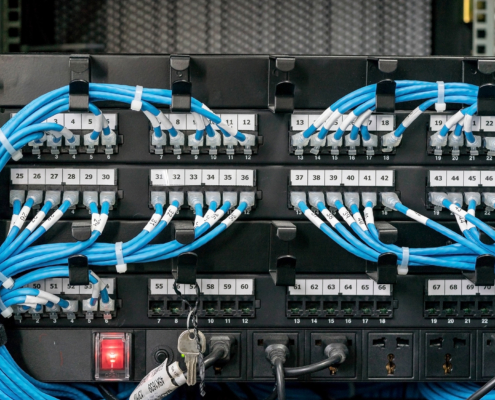 https://ringandping.com/wp-content/uploads/2025/07/Technician-connecting-network-cables-to-switches.-Connecting-cables-in-server-cabinet.jpg12502000Abstrakt Marketing/wp-content/uploads/2024/05/ringandping_logo.svgAbstrakt Marketing2025-07-11 13:47:272025-07-12 13:40:365 Ways Your Business Can Benefit From Improved Warehouse Cabling in Orange County
https://ringandping.com/wp-content/uploads/2025/07/Technician-connecting-network-cables-to-switches.-Connecting-cables-in-server-cabinet.jpg12502000Abstrakt Marketing/wp-content/uploads/2024/05/ringandping_logo.svgAbstrakt Marketing2025-07-11 13:47:272025-07-12 13:40:365 Ways Your Business Can Benefit From Improved Warehouse Cabling in Orange CountyThe healthcare industry is growing and advancing at lightening speed and that advancement is dependent on the latest technology. As a result, a lot more is required of the network cabling infrastructure in healthcare settings as opposed to other standard commercial and office buildings. When designing a network for a healthcare facility there are specific design features laid out in the ANSI/TIA-1179 Healthcare Infrastructure Standard that need to be kept in mind.
The ANSI/TIA-1179 was initiated by a group of healthcare facility end users and over 70 organizations participated in the development. It is an outstanding comprehensive resource when engineering a healthcare network.
Work Area – Unlike most commercial and office spaces, the “work area” is very different in a healthcare facility. Where as in a typical setting, a work area might include computers, phones, and printers; a healthcare facility’s work areas according to the TIA 1179 are broken down into Patient Services, Surgery/Procedure/Operation Rooms, Emergency, Ambulatory Care, Women’s Health, Diagnostic and Treatment, Caregiver, Service/Support, Facilities, Operations, and Critical Care. These 11 work areas are further broken down into Low, Medium, and High density areas which determines the number of outlets required for the space. Patient rooms and nurse stations are considered high density; A lounge or waiting area would be categorized as a low density space. All of the outlets are not required to be located together and in fact, the position of the outlets is best planned to the specific facility and the way they expect that work area to function.
Cabling Pathways – Healthcare facilities require a minimum of two diverse pathways from each equipment room to each telecommunication room. This redundancy is critical because not only does this cabling serve traditional voice and data applications, it is also required to serve critical equipment that could mean life or death for patients.
Large Equipment Rooms – The 1179 standard requires allowing room for 100% growth when designing for a healthcare telecommunications space. This requirement my seem excessive but with the speed that healthcare is advancing, the networking requirements will change and it is important to not have to disrupt the physical space in healthcare facilities if possible. This “room for growth” future-proofs the facility.
Infection Control Requirements (ICRs)- ICRs determine how much access cabling technicians have to cabling pathways. The standard also requires that pathways in air handling spaces be kept enclosed. If using plenum space for cabling, there is strict regulation about how many ceiling tiles may be removed and for how long.
These are only four of the many unique standards for network cabling infrastructure in a healthcare setting. At Ring and Ping Communications, we are experts at designing and engineering networking infrastructure that meets every standard in the TIA 1179 and more importantly meets the needs of the doctors, nurses and hospital staff that will be using it every day. We understand the importance of designing the network to suit your needs. For a free on-site consultation, contact us here or give us a call at (714) 617-4025.
Share This Post
More Like This
 https://ringandping.com/wp-content/uploads/2025/07/Technician-connecting-network-cables-to-switches.-Connecting-cables-in-server-cabinet.jpg12502000Abstrakt Marketing/wp-content/uploads/2024/05/ringandping_logo.svgAbstrakt Marketing2025-07-11 13:47:272025-07-12 13:40:365 Ways Your Business Can Benefit From Improved Warehouse Cabling in Orange County
https://ringandping.com/wp-content/uploads/2025/07/Technician-connecting-network-cables-to-switches.-Connecting-cables-in-server-cabinet.jpg12502000Abstrakt Marketing/wp-content/uploads/2024/05/ringandping_logo.svgAbstrakt Marketing2025-07-11 13:47:272025-07-12 13:40:365 Ways Your Business Can Benefit From Improved Warehouse Cabling in Orange County
The Top LA Warehouse Network Cabling Challenges

Common Warehouse Network Issues and How to Avoid Them at Your Facility

Why Reliable Network Cabling is Vital for Large Warehousing Operations

The Role of Network Cabling in Modern Warehouses

Choosing the Right Network Cabling for Your Warehouse: A Complete Guide

Premise Distribution Systems (PDS) and Why Fiber Optics Are the Future

Network Cabling Troubleshooting: A Complete Guide



